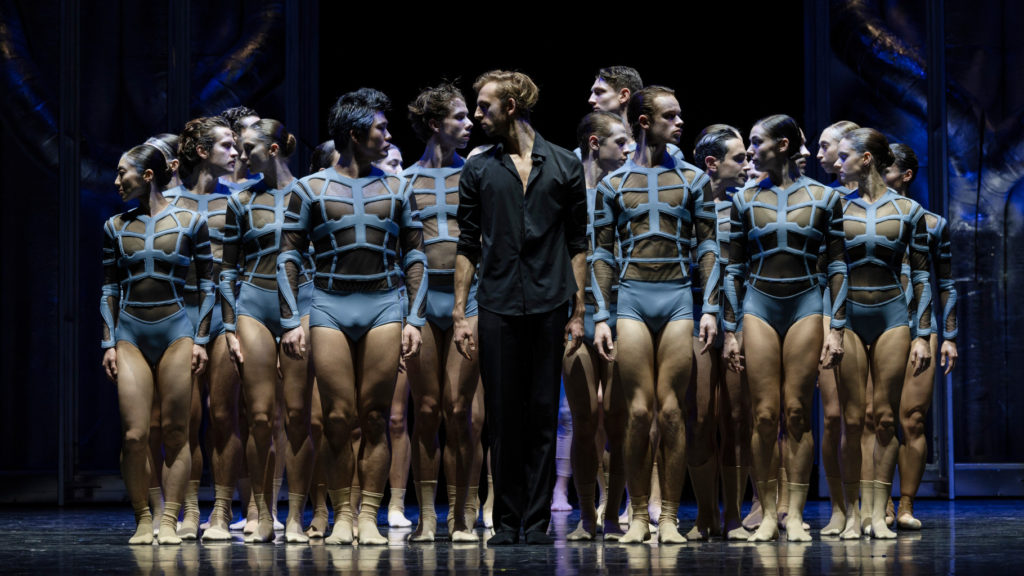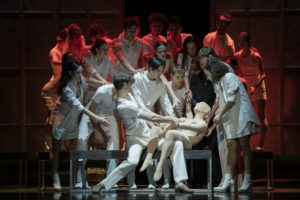Tech World: Hélène Blackburn’s Coppélia X Machina in Düsseldorf - Vancouver Ballet Society
- Home
- Reviews 2020 - 2023
- Tech World: Hélène Blackburn’s Coppélia X Machina in Düsseldorf

By Jeannette Andersen
Hélène Blackburn’s Coppélia X Machina is the latest of numerous ballet interpretations of E.T.A. Hoffmann’s short story The Sandman from 1816. Hoffmann wrote a sinister tale about a young man, Nathaniel, who falls in love with a doll and commits suicide upon realizing she is not human. The story first entered the ballet repertoire with Arthur Saint-Léon’s Coppélia in 1870, turned into what is now a well-known comedic ballet that has Franz falling in love with the doll, Coppélia, created by Dr. Coppélius, but happily marrying his fiancée Swanhilda at the end.
Coppélia X Machina, which premiered with the Ballett am Rhein in Düsseldorf’s opera house in January, where it runs until February 12, is something quite different.

In an interview in the theatre’s playbill, Blackburn, who has led her Montreal-based Cas Public company for over 30 years, explains that she was inspired by both Hoffmann’s story and Saint-Léon’s ballet. I would not have guessed this. In Blackburn’s ballet, there is no Franz, Swanhilda, Coppélia or Coppélius, just three characters listed in the program as Sie (She), Er (He), and Der Macher (The Maker) who are hardly distinguishable from the other 23 dancers. In Act I, costume designer Paul Zoller has everybody wearing white except for one man clad in black. In Act II, they wear light blue tops with a gridline pattern, except for one man in white and one in black. But as the ballet has no discernible story or characters, it is hard to figure out what purpose is served by singling out these dancers in different costumes.
Blackburn also states in the program note that the examination of the relationship between humans and machines is more pressing than ever. Not only our relationship to robots — she raises the question of whether it is possible for a human being to really fall in love with a doll — but also our use of devices like tablets and iPhones. This technology is so ingrained in our lives that its use has become part of our daily movements, and AI is continuously entering more areas of society. These ideas, however, are not apparent in the ballet itself.

Act I is described in the program as being set in a public square, the place of the humans. It looked like an open office space divided into cubicles with invisible partitions. The dancers mostly just moved from one place to the other or pushed benches on or off the stage. Some sat down on the benches and moved their arms and hands as if they were working on a screen at eye level. Sometimes they would reach down as if unplugging the computer.
Act II is described as being set in the world of machines and robots, and at Coppélius’ workshop. Here the dancers mostly repeated movements from Act I, so nothing distinguished machines from humans, with a few exceptions. At the beginning of the act, a dancer on stilts towered menacingly onstage. He was joined by others on stilts, some also using crutches that enabled them to move off-balance like weird creatures. In the end, the fearful atmosphere created by their short appearance amounted to nothing more than a display of what was in store in the workshop. A woman from the world of the machines and a man from the world of the humans engaged in a loving duet, perhaps a reference to Franz and Coppélia, but again nothing more came of it.

For the most part, the ballet seemed simply a series of exquisite images. Perhaps Blackburn’s point is that our lives are already so full of and influenced by machines that we are no longer able to distinguish the two.
Coppélia X Machina was wrapped not in the familiar Léo Delibes music, but in partly existing compositions and partly new ones by contemporary Montreal-based composer Ana Sokolović. Heavy rhythms were at times overlaid by harmonious orchestral compositions with references to Delibes original score. Sokolović’s music evoked the feeling of being in an unforgiving world filled with dreams and was wonderfully played by the Düsseldorfer Symphoniker.
It was Blackburn’s second work for Ballett am Rhein. In 2022, the company’s artistic director, Demis Volpi, featured Balanchine’s The Four Temperaments together with Four New Temperaments, in which Blackburn, Volpi, John Neumeier, and Michèle Anne de Mey each created a piece inspired by one of the temperaments. Blackburn did the Choleric section, pure emotions in a powerful and energetic movement vocabulary, which seemed to fit the dancers perfectly.
All 26 dancers in Coppélia X Machina performed Blackburn’s choreography with precision and expressivity, creating a strong contrast between the work-like movements and the softer ones when interacting. But it was somewhat baffling that the ballet was embedded in the Coppélia story, which created the expectation of having at least some recognizable references, which it did not. Blackburn’s ballet could easily have stood out on its own.

